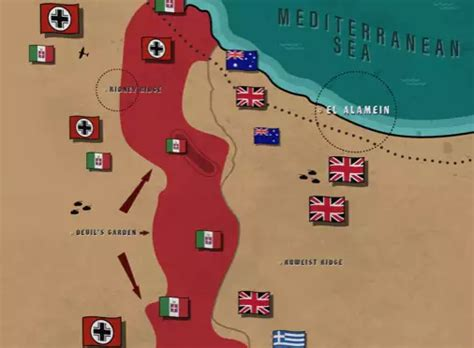Time to go back to El Alamein were in the middle of 1942 there
was great Axis pressure on the desert fighters. It was in June 1942 that Rommel
was finally able to capture Tobruk with 35,000 prisoners of war.
At the end of June, the Australian 9th division was ordered
back to Egypt, arriving in July. The following battles prevented Rommel from
advancing further into Egypt also even though he gained ground this took him
further away from his supply lines in Libya. The Allies bombing of the German supply
ships caused him stress, he was worried about the lack of petrol. In October he
was planning a 12-day battle but only had enough fuel for 11 days.
It was under a full moon on 23 October the Allies let lose a
massive bombardment against Rommel’s lines, at 9pm fire from 900 medium and
field guns lit up the night sky. The front extended about 60 kilometres running
North to South.
There were three phases of the battle with the first two days
being devoted to preparing the way for the Eighth Army to break through the
enemy line. The next seven days and nights saw crumbling operations, with the
final phase saw the Allies break through and Rommel retreating.
Although there was only around 14,000 Aussies involved out of
the 220,000 strong Allies their contribution was considered a crucial one.
The main task of the Aussies was to form a strong flank in the northern
sector they were required to draw Axis fire on the northern flank while other
divisions broke through on the south. The fighting was fierce and at times hand
to hand with many amazing, courageous acts as soldiers stormed the enemy post
dying will doing so.
The 2/48th battalion received four posthumous
Victoria Crosses during the war.
Rommel wrote that the British resisted desperately, with rivers
of blood being poured over miserable stirps of land.
Another miserable but important strip of land was near the
railway and was known as the “saucer”. This position was under attack for
several days and was defended by the 2/24th & 2/28th
and reinforced by a British tank regiment and a Rhodesian battery of anti-tank
guns.
The climax of the battle of El Alamein came at the start of
November with the start of operation Supercharge which succeeded in storming
through enemy lines.
By the end of 1942 even though Aussie’s were still under fire
the prospects were much improved compared with the start of the year. The
Japanese had withdrawn from Papua and the Yanks were fighting back on Guadalcanal.
Northern Australia was now a secure military base for the Aussies and the Yanks.
Winston Churchill said after the battle od El Alamein “his is
not the end, it is not even the beginning of the end, but it is, perhaps the
end of the beginning”.








Interesting how the war went for you in 1942. Didn't totally understand what Churchill meant.
ReplyDeleteYeah the wars was up an down but us Aussie did ok
DeleteI think Churchill meant it was the end of the start of the war but that's just my guess
That took some doing to have the border safe I bet, Jo-Anne.
ReplyDeleteThat it did
DeleteRommel was a very bad man. I'm glad he lost the battle AND the war.
ReplyDeleteYep and he took hos own life in the end
DeleteI love that quote from Winston Churchill, Jo-Anne. What a great leader he was!
ReplyDeleteMany say he was, I don't know but think he may have been
DeleteThat is a section of the war I need to target for my next book buy!
ReplyDeleteI find all history pretty interesting
Delete